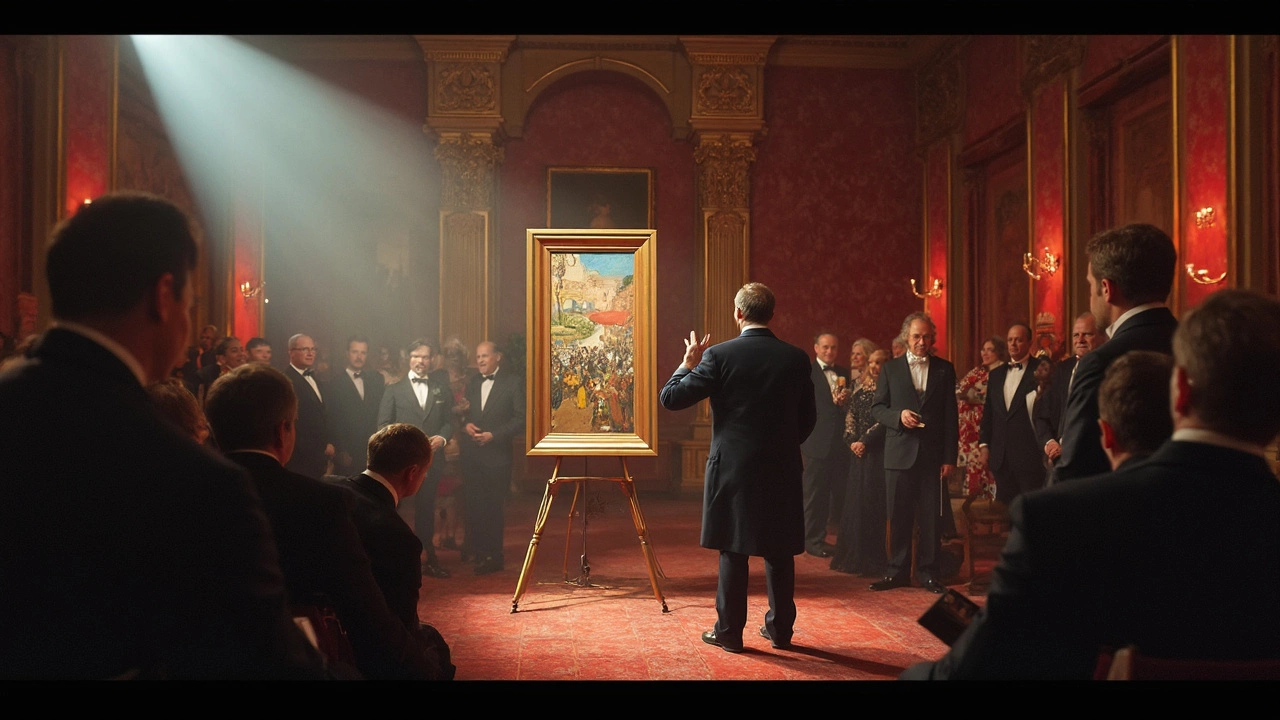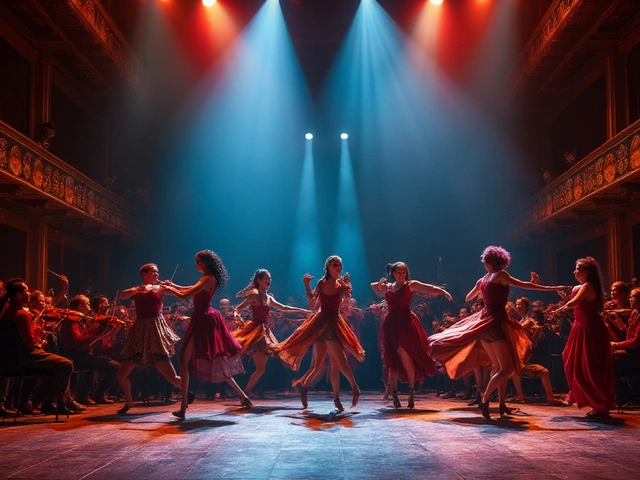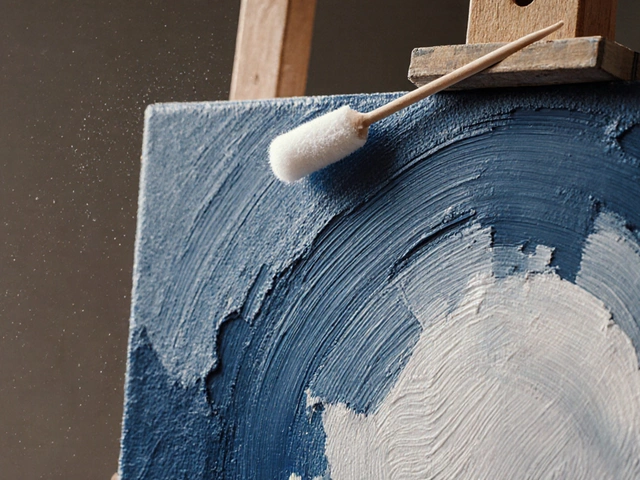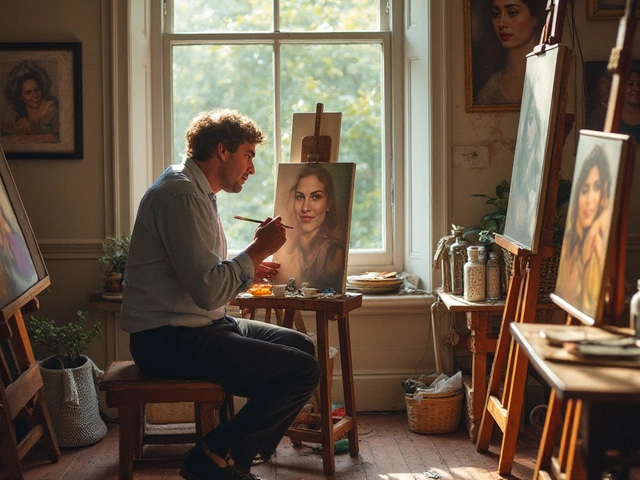If you’ve ever wondered how much someone would really pay for a modern painting, brace yourself. The most expensive modern art piece ever sold isn’t just a shopping spree—it’s a lesson in how wild the art world can get. We’re talking mind-blowing sums, secretive buyers, and unexpected twists that even art lovers find hard to believe.
Sure, you’ve seen headlines about pricy works before. But did you know the modern art crown is currently held by Leonardo da Vinci’s ‘Salvator Mundi’, which went for $450.3 million at Christie’s in 2017? Yes, there’s still debate over whether to call da Vinci “modern,” but this record sale set the pace for everything that followed. And when you dig into the reasons why it reached that price, you see it’s not just the paint on canvas, but hype, history, and the personalities behind the money that drive sales up.
The numbers don’t lie: modern art—roughly anything from the late 19th century onward—regularly smashes records, creating a ripple effect across the industry. Even if you’re only casually interested in art, knowing what fuels these massive auction prices is surprisingly useful. It reveals what collectors look for, how trends catch fire, and where the money flows.
- Record-Breaking Sale: The Big Number
- Who Bought It (and Why That Matters)
- Why Did It Sell for So Much?
- How Auctions Set Art World Records
- Impact on the Modern Art Market
- Tips for Navigating Modern Art Prices
Record-Breaking Sale: The Big Number
Let’s get right to it: the most expensive modern art piece ever sold is ‘Salvator Mundi’ by Leonardo da Vinci. It didn’t just set a record, it blew the doors off. The hammer dropped at $450.3 million during a Christie’s auction in New York on November 15, 2017. People couldn’t believe it then, and it’s still a hot topic now—both for the massive number and for the painting’s mysterious journey.
What made this sale so headline-grabbing wasn’t just the price tag. Before the auction, ‘Salvator Mundi’ had been lost for centuries, and then after restoration, arguments broke out over whether it was a true da Vinci or mostly a product of his workshop. Despite all that noise, buyers lined up. The winning bid reportedly came from a Saudi prince on behalf of the crown prince, Mohammed bin Salman, though the buyer kept their identity quiet for months.
Here’s a quick look at the numbers involved:
| Artwork | Artist | Sale Price | Year Sold | Location |
|---|---|---|---|---|
| Salvator Mundi | Leonardo da Vinci | $450.3 million | 2017 | Christie’s New York |
To put that in perspective, the previous record for a painting was Pablo Picasso’s ‘Les Femmes d’Alger (Version O)’, which sold for $179.4 million in 2015—barely half of what ‘Salvator Mundi’ pulled in. Art experts and auctioneers still use this sale as the gold standard for how high modern art prices can go.
If you’re wondering if anything’s even come close since, the answer is no. Not for a single painting, anyway. The market keeps chasing that number, but so far, ‘Salvator Mundi’ is still king of the hill.
Who Bought It (and Why That Matters)
When ‘Salvator Mundi’ got snapped up for over $450 million, the art world went nuts trying to figure out who wrote the check. The winning bidder? Officially, it was Prince Badr bin Abdullah bin Mohammed bin Farhan al Saud, a little-known Saudi prince at the time. But here’s the twist: reports later showed he was acting for Saudi Crown Prince Mohammed bin Salman. The choice isn’t random—owning such a piece is a prestige move and says a lot about power and influence.
Why does this matter? Because when a royal or a billionaire collector grabs the most expensive modern art piece, it’s not just about the painting. It’s a flex, a way of signaling status, and sometimes a tool for diplomacy. For Saudi Arabia, landing a da Vinci cast a bright spotlight on the country’s push to shake up its image—from oil giant to global culture player.
Breaking it down, here’s why the buyer’s identity can totally change the impact of a record-breaking artwork:
- Global attention: Private buyers from big-deal countries turn art sales into headlines that reach far beyond art news. Suddenly, everyone’s talking about Saudi Arabia’s interest in Western culture.
- Collector clout: When elites buy art, it encourages other wealthy buyers to join the frenzy, which can drive prices up for other pieces by association.
- Art accessibility: The buyer decides if the world sees the work or if it just sits in a private collection. For example, ‘Salvator Mundi’ has been out of public view ever since the sale, leaving tons of people wondering if it’ll ever be seen again.
All this goes to show, it’s not just the artist or the artwork that matters; who owns it and what they do with it can change the whole conversation around modern art. Big-name buyers mean big waves, not just in art but across politics, media, and culture.
Why Did It Sell for So Much?
It’s easy to think that expensive art is all about talent or beauty, but honestly, that just scratches the surface. The jaw-dropping price tag of the most expensive modern art ever sold—‘Salvator Mundi’—comes down to a cocktail of factors, some obvious and some hidden behind closed doors.
First up, its creator. Leonardo da Vinci isn’t just any artist; he’s a legend. Anytime an authentic da Vinci painting comes up, it’s like a moon landing for art lovers. For years, ‘Salvator Mundi’ was thought lost, and then its rediscovery triggered a storm of excitement. People started to see it as “the last da Vinci in private hands”—that rarity jacked up the price even before auction day.
Next, there’s the hype factor. The auction house, Christie’s, basically turned the sale into a global event. They launched a marketing campaign that showed the painting in glamorous cities like Hong Kong, London, and New York. Videos of people breaking down in tears while seeing it for the first time made the rounds online. The buzz brought rich collectors from all over the world.
Let’s not forget the bidding war. On the night of the sale, the auction room was packed with phone bidders as well as in-person hopefuls. Every new bid just kept raising the stakes, and nobody wanted to give in. The art market thrives on these high-drama moments, where ego and status play a huge part.
Provenance matters too. The painting has a complicated backstory, shifting between royal hands, disappearing for centuries, then getting “rediscovered” and restored. Every step in that journey made people want it more, and that spiced up the value big time.
On top of all this, some people buy art like others buy stocks. They’re betting that the painting will get even more famous, so they see it as an investment—one that could pay off way down the road. Even though ‘Salvator Mundi’ cost $450.3 million, the buyer might see it as something that will grow in value, or at least impress everyone who visits their private collection.
Here’s a quick breakdown of what really pushed that price off the charts:
- Famous creator: Leonardo da Vinci’s name alone raises stakes
- Extreme rarity: The only da Vinci painting outside a museum
- Media buzz: Massive global campaign drove interest
- Historic journey: A story with drama and mystery
- Investment value: Seen as a status symbol and potential asset
So, the price wasn’t just about paint and canvas. It’s a mix of history, hype, name recognition, scarcity, and even a little fear of missing out—that classic auction magic.
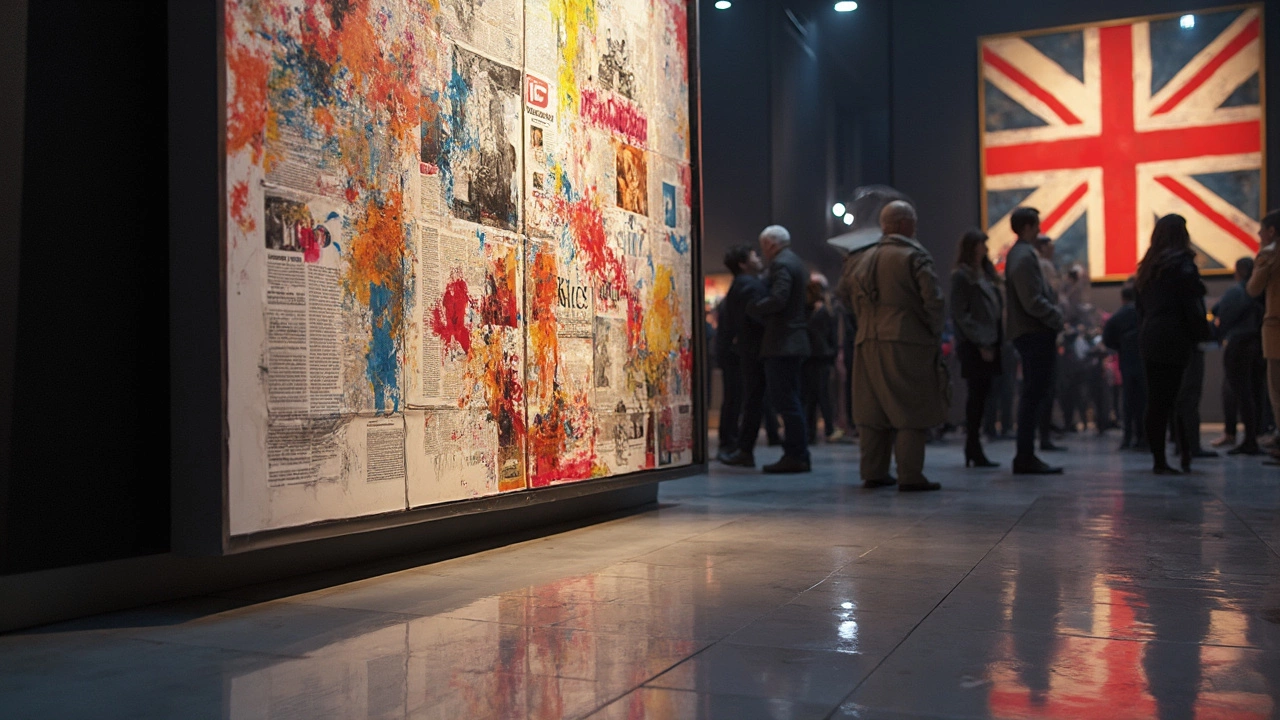
How Auctions Set Art World Records
Art auctions aren’t just fancy parties with canapés and flashbulbs. They’re engineered to raise prices and craft buzz around every piece. When it comes to setting records, auction houses like Christie’s and Sotheby’s play a game that’s part theater, part serious financial chess.
Here’s how it works: Before the big night, experts carefully pick which works to offer, sometimes nudging ultra-wealthy collectors to sell at just the right moment. They’ll hype the piece weeks in advance with glamorous previews, all designed to whip up excitement and bring in the world’s top bidders.
Reserve prices matter—a lot. That’s the secret minimum price the seller will accept, set in private. If bidding doesn’t hit that number, the piece doesn’t sell (so you won’t always see the flashy results in the headlines).
Bidding itself is a show. You might see intense bidding wars, sometimes between anonymous phone bidders with art advisers in their ear. This drama isn’t just for effect; it drives the price up, sometimes way beyond the original estimate. Just ask anyone who watched the 'Salvator Mundi' sale—bidding started near $100 million and went up by eye-popping increments until the hammer fell at $450.3 million, shattering the previous modern art record.
Another little-known fact: some lots are offered with guarantees. This means a third party, usually a deep-pocketed investor, promises to buy the work no matter what, taking risk away from the seller. This safety net can push sellers to consign more valuable pieces and attract huge pre-sale attention. But it can also make the market look more robust than it really is.
Here's a look at a few record-breaking auction prices in recent years:
| Artwork | Artist | Year Sold | Final Price (USD) |
|---|---|---|---|
| Salvator Mundi | Leonardo da Vinci | 2017 | $450.3 million |
| Shot Sage Blue Marilyn | Andy Warhol | 2022 | $195 million |
| Les Femmes d'Alger (Version O) | Pablo Picasso | 2015 | $179.4 million |
The real kicker? Many auction records are set because two or more billionaires simply refuse to back down. It’s part ego clash, part investment strategy. And when that happens, you get the most expensive modern art piece—and a rush of headlines that keep the art world spinning.
Impact on the Modern Art Market
You might wonder: what actually happens to the modern art market when a piece sells for hundreds of millions? Well, it’s like a rock tossed in a calm lake—the ripples are huge and long-lasting. When 'Salvator Mundi' hit that $450 million mark, it didn’t just break a record; it totally changed expectations for what people might pay for other works, especially from headline artists.
Sellers suddenly felt emboldened to bring big-name paintings out of private vaults and into auction houses. Auction houses like Sotheby’s and Christie’s saw more daring consignments and ambitious pricing. There was an immediate jump in insurance costs, and buyers, spooked by the size of the deals, got more cautious about what to chase after.
The sale also drew a rush of new collectors into the scene—especially from Asia and the Middle East. Fresh faces saw art less as an academic pursuit and more as a bold investment. Big banks even started offering special art loans (sometimes using a painting as collateral). This brought a new financial energy to the whole game.
If you check out recent auction stats, you’ll see a clear spike in modern and contemporary sales after these headline grabs. Here’s a quick look at public data from major auction houses:
| Year | Total Modern Art Sales (USD) |
|---|---|
| 2016 | $4.8 Billion |
| 2017 | $6.2 Billion |
| 2018 | $5.9 Billion |
| 2019 | $6.1 Billion |
Those big numbers aren’t just because of one painting, but that headline record lit a fire. If you’re a regular collector or just getting into art, this means you can expect prices to stay high and competition intense for sought-after works. But keep in mind, the splashy sales mostly push prices for a handful of top artists higher, while emerging artists might still be affordable.
If you want to play the art market, watch what’s happening to the most expensive modern art at auction. When records fall, the whole market tends to shift a bit—even if it’s mostly about bragging rights for billionaires.
Tips for Navigating Modern Art Prices
If you think the most expensive modern art headlines are way out of your league, you’re not alone. But there are real ways to make sense of how prices work and spot what’s heating up—and what’s a risky bet.
First, always check past sales data. Platforms like Artnet and Sotheby’s let you see what similar works have gone for in recent years. Christie’s even lists results for public viewing, so you’re not working in the dark. For example, Basquiat paintings shot from $100,000 to over $110 million in just 35 years—body of work, story, and market demand all matter.
- Don’t skip the basics. The artist’s reputation, the year the piece was created, and the size matter a lot. A tiny early Picasso can sell for less than a giant late-period one with the right pedigree.
- Watch for market buzz. If you keep seeing an artist pop up in museum shows or big auctions, prices can jump. But hyped pieces also come with risks—sometimes the attention fades fast.
- Understand auction fees. The "hammer price" isn’t the end. Buyers pay a hefty premium—sometimes 20% or more—on top of that number. Always check the full cost.
- Compare private sales and auctions. Private deals sometimes go higher for sought-after pieces. Data from Art Basel and UBS found about $36.7 billion was spent in private art sales in 2023, showing not everything happens in the open.
- Get it checked. Provenance (the art’s history) and authenticity drive value. Gaps or confusion—especially in modern art—can crush prices when doubts pop up later.
Here’s a quick comparison to make things clearer:
| Sale Type | Price Transparency | Buyer Fees |
|---|---|---|
| Auction | Public | 15-25% |
| Private Sale | Usually Confidential | Negotiable |
No matter your budget, knowing these factors makes you a smarter buyer—or just helps on trivia night when someone asks about blockbuster art sales. If you spot those trends early, who knows; maybe you’ll see your own piece climb the charts someday.
